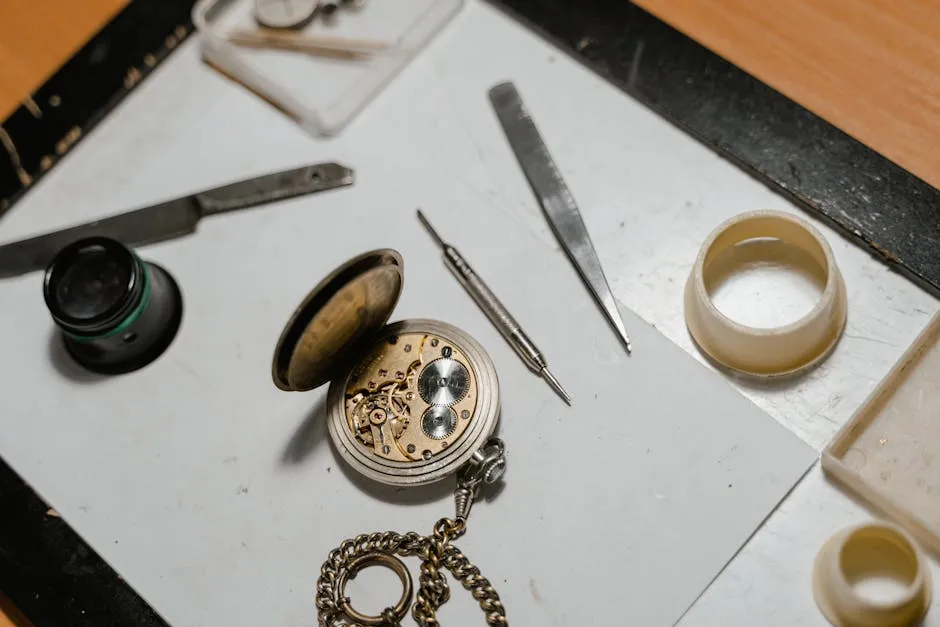
Why Does My Accutron 218 Start and Stop? Troubleshooting the Classic Timepiece
Introduction
The Accutron 218 is not just a watch; it’s a piece of history. Launched in the 1960s, it revolutionized timekeeping with its unique tuning fork mechanism. This innovative approach made it the first electronic watch, earning a special place in the hearts of watch enthusiasts and collectors alike. However, like any classic, it has its quirks. One common issue? This beauty may start and stop unexpectedly, leaving you scratching your head.
Imagine this: you proudly wear your Accutron 218, and suddenly, it stops. Is it a ghost in the machine or just a simple hiccup? Fear not! This article is your trusty guide to troubleshooting your timepiece. We’ll navigate the mysteries of the Accutron 218, so you can keep it ticking proudly. Whether you’re a seasoned collector or a newbie, we’ve got tips and tricks to help you understand and resolve this perplexing problem. Let’s get your watch back to its rhythmic hum!

Summary of Key Points
So, why does your Accutron 218 start and stop? There are a few common culprits. First, battery maintenance is crucial. If you’re using an old battery, it might just be time for a fresh Renata 344. Secondly, battery contact issues can arise. Corrosion can be a sneaky foe, hindering power flow. Lastly, the coil’s functionality is vital. If the coils aren’t working, your watch won’t either.
The Accutron 218’s tuning fork mechanism sets it apart from traditional timepieces. Unlike mechanical watches that rely on a balance wheel, the 218 uses a vibrating tuning fork to keep time. This precision technology is why many enthusiasts cherish it. However, it also means that specific issues can arise, leading to the watch starting and stopping.
Stay tuned for detailed troubleshooting steps and expert advice in the upcoming sections! We’ll dive into the nitty-gritty of battery checks, coil examinations, and more. Your Accutron 218 will soon be humming smoothly again!

Understanding the Accutron 218
Overview of the Mechanism
The Accutron 218’s magic lies in its tuning fork mechanism. Instead of the traditional balance wheel, it uses a tuning fork that vibrates at a high frequency—360Hz, to be precise. This innovative design allows for remarkable accuracy, making it one of the most precise watches of its time.
Imagine how this technology changed watchmaking! The tuning fork’s oscillation is maintained by an electronic circuit, ensuring consistent power delivery. This means fewer moving parts and reduced friction, leading to a longer lifespan for the movement. In a world where accuracy is king, the Accutron 218 reigns supreme.
With this understanding of its mechanism, troubleshooting becomes much clearer. Knowing how it works will help you appreciate the intricacies involved when your beloved watch starts and stops. So, let’s keep the gears turning and your curiosity piqued as we explore common issues next!

Common Issues with the Accutron 218
The Accutron 218 is a marvel of watchmaking, but it’s not without its hiccups. One of the most common complaints? Starting and stopping. You might glance at your wrist, expecting to see the time, only to find your beloved watch in a state of indecision. It’s like it’s pondering life’s biggest questions!
But that’s not all. Inaccurate timekeeping can drive you nuts, especially if you’re one to arrive fashionably late. Erratic behavior can also pop up, leaving you feeling like your watch is playing hide-and-seek with the proper time. Let’s break down these common problems further.
- Starting and Stopping: The watch might stop suddenly after a few minutes of operation. This could be due to a weak battery, poor contacts, or even a malfunction in the tuning fork mechanism. It’s worth noting that if your watch starts humming again after a gentle shake, you might be dealing with a minor issue—perhaps just a little nudge is all it needs!
- Inaccurate Timekeeping: If your Accutron is running fast or slow, it could indicate problems with the battery or the coils. In some cases, the tuning fork may be out of phase, which can mess with its ability to keep precise time. After all, who wants a watch that thinks two minutes ahead of schedule?
- Erratic Behavior: Erratic behavior might present itself as a second hand that jumps or skips. This could be caused by dirty battery contacts, a failing movement, or other internal issues. If you find yourself perpetually adjusting your watch, it’s time to take a closer look!
Understanding these common issues helps demystify the quirks of your Accutron 218. With a little patience and troubleshooting, you can get your watch back to its reliable self, ready to keep time with precision. Now, let’s dive deeper into the troubleshooting process!
Troubleshooting Your Accutron 218
Checking the Battery
Importance of Battery Choice
Choosing the right battery for your Accutron 218 is critical. The recommended type is the Renata 344. This battery type ensures compatibility with the tuning fork mechanism, providing the necessary power for smooth operation. Using a low-quality or incorrect battery can lead to frustrating performance issues, including the dreaded starting and stopping.
Why is this choice so crucial? Well, think of it this way: your watch is like a car—it needs the right fuel to run efficiently. A fresh, high-quality battery will keep your watch humming along without interruption. And remember, old batteries can leak, corrode, and wreak havoc on your watch’s delicate components. So, don’t skimp on this vital part!

Battery Installation Tips
Now that you have the right battery, let’s ensure it’s installed correctly. Here’s how to check and install the battery:
- Turn Off the Watch: Before you begin, make sure your watch is turned off to avoid any electrical mishaps.
- Open the Case Back: Using a case opener, carefully remove the case back. Take your time; you don’t want to damage the delicate components inside. You can grab a Watch Case Opener Tool to help with this step!
- Remove the Old Battery: If there’s an old battery, gently pry it out using a non-metallic tool to avoid any short-circuiting.
- Clean the Contacts: Before inserting the new battery, check the contacts for any corrosion or dirt. Clean them carefully with a soft cloth or a cotton swab dipped in isopropyl alcohol. Clean contacts lead to better performance!
- Insert the New Battery: Place the Renata 344 battery in the compartment with the positive side down. This is crucial! Installing it the wrong way can prevent your watch from working.
- Reattach the Case Back: Securely replace and tighten the case back, ensuring everything is snug but not overly tight.
- Test the Watch: Gently tap the side of the watch or give it a little shake. If it starts humming, congratulations! You’ve likely fixed the problem.
Following these steps should have your Accutron 218 ticking away smoothly once more. If the issue persists, it might be time to check the battery contacts or look deeper into the movement. Keep your trusty timepiece running like the classic it is!

Examining the Coils and Electronics
Understanding Coils and Their Function
The coils in your Accutron 218 are essential for its unique operation. Think of them as the watch’s power lifters, helping the tuning fork do its job. The tuning fork vibrates at a high frequency, and it’s the coils that convert this mechanical energy into electrical impulses. This process keeps your watch ticking like it just won the lottery!
Over time, coils can face wear and tear. Just like your favorite pair of sneakers, they might not perform so well after a while. A common issue is the breaking of a wire strand in the coil. This failure can lead to erratic behavior, making your watch start, stop, or even hum without moving the hands. Imagine having a pet cat that suddenly decides to ignore you—frustrating, right?
Environmental factors can also impact coil performance. Humidity, temperature changes, and even dust can cause the coils to malfunction. Neglecting regular maintenance might make the coils susceptible to corrosion. Just like a rusty bicycle chain, these tiny components need care to keep everything running smoothly.
If you notice your Accutron 218 has developed an attitude, the coils might be the source of its mood swings. In many cases, replacing or repairing the coils can restore your watch to its former glory. So, if your watch is starting and stopping like a confused squirrel, it’s time to give those coils some attention!
Testing Coils for Functionality
Ready to play detective with your Accutron 218? Grab a multimeter! This handy tool will help you determine if your coils are functioning properly. Here’s a step-by-step guide to testing coil resistance:
- Safety First: Ensure your watch is powered off before starting any examination. You don’t want to accidentally short-circuit anything—yikes!
- Open the Case Back: Use a case opener to gently remove the back cover. Take your time; we want no scratches on this beauty!
- Locate the Coils: Identify the coils inside the movement. They typically sit at the top, close to the tuning fork.
- Set the Multimeter: Switch your multimeter to the resistance (Ω) setting. This will help you measure the electrical resistance of the coils.
- Measure Resistance: Touch one probe to each lead of the coil. A functional coil should show a specific resistance value—usually between 20 and 30 ohms. If the reading is significantly higher or shows infinite resistance, the coil is likely damaged.
- Check for Shorts: Make sure to check for shorts between the coil leads and the watch casing. If there’s continuity, your coil has a serious issue.
- Reassemble: If everything looks good, carefully reassemble your watch. If not, it might be time to consider a coil replacement.
Testing the coils can be a straightforward task that saves you a trip to the watchmaker. If your multimeter reveals a problem, don’t fret! Understanding these components can lead to a simple fix or professional help down the line. Keep that Accutron 218 ticking like a pro!
Adjusting the Movement and Regulation
Phasing and Regulation Explained
Ah, phasing—the mysterious art of making your Accutron 218 behave! Phasing refers to the synchronization of the tuning fork’s vibrations with the movement’s gear train. When everything is in sync, your watch will tick like a metronome. But if it’s out of phase, it could lead to all kinds of timekeeping chaos.
Think of phasing as the dance between the tuning fork and the movement. If they’re not in sync, your watch might run slow, fast, or even stop altogether. It’s like trying to dance to different beats at a party—awkward and frustrating!
A common sign of phasing issues is inconsistent timekeeping. If you find your watch gaining or losing time, it’s a red flag. You might even notice the second hand skipping or stuttering. This erratic behavior can be traced back to improper phasing, which can often be adjusted with a little finesse.
Achieving proper phasing requires a delicate touch and sometimes special tools. If you’re feeling adventurous, you can try adjusting the movement yourself. However, if you’re unsure, seeking professional help is always a wise choice. After all, you wouldn’t want to accidentally turn your watch into a fancy paperweight!

DIY Adjustment Tips
Ready to roll up your sleeves and tackle some DIY adjustments? Here’s how to get started on fine-tuning your Accutron 218’s movement.
- Gather Your Tools: You’ll need a case opener, a small screwdriver set, and a toothpick (yes, a toothpick!). This combo is perfect for making delicate adjustments without damaging the movement.
- Open the Case: Carefully remove the case back to access the movement. Take a moment to admire the craftsmanship inside—it’s like a tiny engineering marvel!
- Locate the Regulator: Find the regulator on the movement. This little gem is usually a small lever near the balance wheel.
- Make Adjustments: Gently move the regulator towards the “+” for a faster rate and towards the “-” for a slower rate. Small adjustments can make a big difference, so keep it subtle!
- Check the Second Hand: After making adjustments, give the watch a little shake and observe the second hand. Is it moving smoothly? Great! If not, you might need to tweak it a bit more.
- Reassemble and Test: Once you’re satisfied, carefully reattach the case back. Test your watch over the next few days to see if the timekeeping improves.
Remember, patience is key! Adjusting the movement can feel like a balancing act, but with practice, you’ll become a pro. If the problem persists or you feel uncertain, don’t hesitate to consult a watchmaker. Keeping your Accutron 218 in top shape is worth the effort, and soon enough, you’ll have a beautifully regulated timepiece again!

Seeking Professional Help
When to Consult a Watchmaker
Sometimes, despite your best efforts, your Accutron 218 might still refuse to cooperate. If you’ve tried new batteries, cleaned contacts, and even given it a gentle shake, it’s time to consider a professional. Watchmakers are like the superheroes of horology, equipped with tools and knowledge to tackle the toughest challenges.
First off, if your watch shows signs of severe damage, don’t hesitate. Cracks, scratches, or a stuck movement are red flags. These issues can lead to more extensive damage if left unchecked. A watchmaker can assess the situation and provide solutions that will preserve your precious timepiece.
Another sign to consult a professional is erratic behavior that persists after basic troubleshooting. If your watch starts and stops unpredictably, or if the second hand jumps inconsistently, it may indicate deeper mechanical issues, like problems with the coils or the tuning fork itself. These components require expertise to repair or replace.
Lastly, if your watch has been idle for years, it’s best to have it serviced. Dust and moisture can wreak havoc on delicate watch mechanisms. A thorough cleaning and lubrication can breathe new life into your Accutron 218, ensuring it runs smoothly for years to come.
Remember, your Accutron is not just a watch; it’s a piece of history. Entrusting it to a professional ensures that it receives the care it deserves. So, when in doubt, don’t hesitate to reach out to a watchmaker who specializes in vintage timepieces. Your watch will thank you!

Conclusion
In summary, troubleshooting your Accutron 218 can be an engaging adventure. Start with simple checks like battery replacement and cleaning contacts. Often, these steps resolve common issues. Remember to stay vigilant for signs of malfunction, such as erratic timekeeping or sudden stops.
Regular maintenance is vital. Like any classic car, your watch needs care to keep it running well. Always use high-quality batteries and ensure proper installation. This routine can significantly extend the life of your timepiece.
Owning an Accutron 218 is a journey filled with quirks and surprises. Embrace these challenges! Each hiccup is an opportunity to learn more about your watch and its history. Plus, there’s immense satisfaction in solving its mysteries yourself.
So, whether you choose to troubleshoot on your own or enlist professional help, enjoy the process. Your Accutron 218 is a remarkable piece of technology and history that deserves to keep ticking proudly. Happy timekeeping!

FAQs
Why does my Accutron 218 run fast or slow?
If your Accutron 218 is running fast or slow, several factors could be at play. First, check the battery condition. A weak battery can cause irregular timekeeping. The recommended Renata 344 battery is your best bet! Next, the watch’s regulation might need adjustment. If the tuning fork is out of phase, it can result in inaccurate time. A tiny tweak can make a big difference, so don’t hesitate to consult a professional if needed.
What should I do if my watch stops completely?
A complete stop can be frustrating! Start with the basics. First, check the battery. Is it fresh? If it hasn’t been changed in a while, it may be time for an upgrade! If the battery is good, inspect the battery contacts for corrosion. Clean them gently with a soft cloth. If the watch still refuses to budge, consider checking the coils and movement. Sometimes, a little nudge is all it takes to get it back on track!
Can I replace parts myself, or should I hire a professional?
Ah, the age-old DIY debate! While replacing parts yourself can save money, it’s crucial to weigh the pros and cons. DIY repairs can be rewarding but risky. A wrong move could lead to more damage. If you’re confident in your skills, go for it! However, if you’re unsure or face complex issues, hiring a professional is wise. They have the expertise and tools to handle your classic timepiece with care and precision.
How do I know if my battery is dead?
Is your watch playing hard to get? First, check the voltage. Using a multimeter, test the battery—anything below 1.35 volts indicates it’s time for a change. Signs of battery failure include a watch that stops suddenly or erratic timekeeping. If your watch stops, don’t panic! Replace the battery and see if it springs back to life. If not, other issues might be lurking beneath the surface.
What maintenance does my Accutron 218 need?
To keep your Accutron 218 ticking like new, routine maintenance is essential. Start with regularly changing the battery—every 1-2 years is ideal. Also, check the battery contacts for any signs of corrosion. Cleaning them gently can improve performance. Additionally, give your watch a spa day with a professional service every few years. This ensures all parts are lubricated and functioning correctly, prolonging the life of your beloved timepiece. Remember, a little care goes a long way!
Please let us know what you think about our content by leaving a comment down below!
Thank you for reading till here 🙂
If you’re wondering about the common issues with the Accutron 218, check out this article for more insights. why does my accutron 218 start and stop
All images from Pexels




